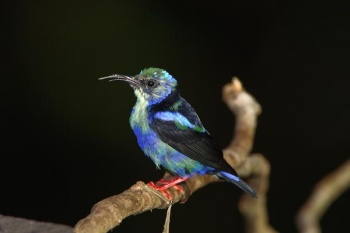- Cyanerpes cyaneus
Identification
12 cm
Long, slightly decurved black bill, black eye, short tail.
Male in breeding plumage: purple-blue with black lores, mantle, wings and tail, purple-blue scapulars and rump, turquoise crown, yellow underwings, red legs. Male in non-breeding plumage: Green overall, but black in tail and wings still there; above the black lore is a pale stripe, and the throat and underparts are streaked lemon.
Female green overall including upper wings and tail, with yellow underwings. Similarly to non-breeding male, but has lemon streaking on underparts that become more solid lemon on belly and undertail coverts. Dusky-black lores with a pale supraloral stripe continuing above and behind the eye and reddish legs.
Immature green overall; the males moult and put on their distinctive colours a bit later.
Similar species
Short-billed Honeycreeper shares red legs, but differs in blue crown same colour as the mantle (not lighter turquoise) and blackish throat and breast, and a shorter bill. Shining Honeycreeper and Purple Honeycreeper additionally differ in yellow legs.
Distribution
Southern Mexico and Cuba through Central America to Bolivia and Brazil as well as both Trinidad and Tobago.
Taxonomy
Subspecies[1]
- C. c. carneipes: Gulf slope of southern Mexico to northern Colombia; Coiba Island and Pearl Island
- C. c. gemmeus: Northern Colombia (Serranía de Macuire on Guajira Peninsula)
- C. c. pacificus: Pacific coast of western Colombia and western Ecuador
- C. c. gigas: Gorgona Islands (off Pacific coast of Colombia)
- C. c. eximius: Tropical northern Colombia to northern Venezuela; Isla Margarita
- C. c. dispar: Eastern Colombia to southern Venezuela, western Brazil and north-eastern Peru
- C. c. tobagensis: Tobago
- C. c. cyaneus: Tropical south-eastern Venezuela to the Guianas and north-eastern Brazil; Trinidad
- C. c. brevipes: Central Amazonian Brazil
- C. c. holti: Eastern Brazil
- C. c. violaceus: Central Bolivia and western Brazil
Habitat
Humid forests, deciduous forests, woodland edges, shrubby areas, plantations.
In Trinidad described as a "wanderer" outside breeding season, where it can turn up in unexpected places.
Behaviour
It feeds on insects and nectar from flowering trees, but will also visit fruit feeders.
References
- Clements, JF. 2008. The Clements Checklist of Birds of the World. 6th ed., with updates to December 2008. Ithaca: Cornell Univ. Press. ISBN 978-0801445019.
- BF Member observations
Recommended Citation
- BirdForum Opus contributors. (2024) Red-legged Honeycreeper. In: BirdForum, the forum for wild birds and birding. Retrieved 25 April 2024 from https://www.birdforum.net/opus/Red-legged_Honeycreeper
External Links
GSearch checked for 2020 platform.1






